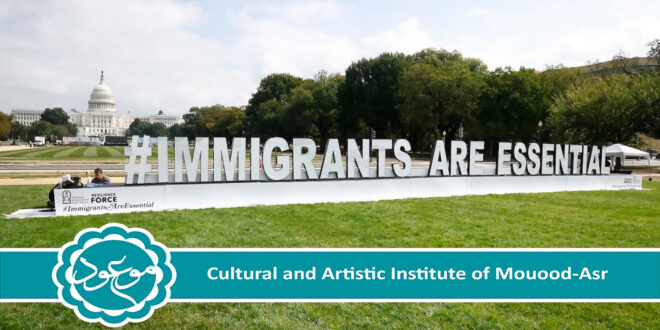Quoting by Foreign Policy, Mouood reports: Who Will Win the Global War for Talent?
After the Great Lockdown will come the next Great Migration.
By Parag Khanna, the founder and managing partner of FutureMap.
Three crises are slamming the world at the same time: the COVID-19 pandemic, climate change, and a population plateau. But once COVID-19 passes, immigration will surge again as countries seek workers to fill labor shortages and people flee climate-stressed regions in search of stable habitats. Although this may seem improbable amid COVID-19 border restrictions and today’s toxic political discourse, xenophobic populism will soon be jettisoned in favor of an all-out war for young talent.
The only question is which countries realize it first.
The winners in this new round of the global war for talent won’t just be the usual suspects (the United States and Britain)—although, fortunately, despite their harsh responses to crises like the surge in Haitian and African asylum-seekers, these traditional immigration magnets are returning to the expansionist migration policies that pre-date former U.S. President Donald Trump and Brexit.

U.S. President Joe Biden has let the Trump administrations’ H-1B visa ban expire, is allowing H-1B dependents to obtain work, and is pushing to ease the path toward immigration for foreign graduates. It’s been said many times and may finally come true: Foreign students should be granted green cards with their diplomas.
In the United Kingdom, British Prime Minister Boris Johnson has pledged to put “people before passports.” The country admitted more than 35,000 non-European Union foreign students in 2020, up 2 percent from the previous year. Furthermore, the Home Office recently unveiled a new “high potential individual” scheme that will grant visas to any foreigners who graduate from a recognized university, even without the previously required proof of job offer. When it comes to immigration policy, it seems Brexit was just a blip.
What comes next will be far more interesting than a return to the usual patterns and pairings of migration origin and destination countries. New directions of travel and vectors of opportunity are emerging that will see new countries around the globe competing for the best and brightest.
Which unheralded countries may soon enter the immigration big leagues? Two candidates, Canada and Japan, present superb credentials. At the same time, countries off the beaten track, such as Kazakhstan, are already showing signs of becoming tomorrow’s major immigration magnets.
Canada: the immigration superpower
While the United States convulses over immigration policy, its spacious neighbor to the north has far fewer qualms.
With one-tenth of the United States’ population, Canada takes in nearly the same number of migrants as the United States each year, with an official target of 401,000 people for 2021. In 2019, Canada granted permanent residency to more Indian nationals than the United States did. Canada’s stock of foreign students (more than 530,000 people) is about half that of the United States, indicating a higher appetite for eager youth.
And unlike in the United States, the Canadian citizenship journey begins as soon as a student lands in the country. Its recently launched Start-Up Visa Program also gives generous grants to tech company founders to relocate to Canada and bring their ideas to life.
Canada embodies the notion that immigration policy is economic policy—a view the country’s major political parties agree on. Its immigrant surge coincides with oil’s declining centrality in the world economy, and the country is betting on a more diversified economy focused on manufacturing and services.
Its aging population requires caregivers, its eastern and maritime provinces need to be rejuvenated with new industries from information technology to hydropower, its booming agriculture sector requires new infrastructure and irrigation, and connecting its oil patch and farmlands to global markets requires new pipelines and a vast freight-rail network.
There aren’t nearly enough Canadians to do it all. The combination of its own economic diversification, population expansion through immigration, and the U.S.-Mexico-Canada Agreement kicking in should propel Canada’s economy ahead of Britain’s over the coming decade, growth that—in itself—will attract more migrants.
Canada’s major cities, such as Toronto and Vancouver, have long been immigrant magnets, but their cost of living is soaring. The country’s 2021 budget contains significantly greater resources for the Canada Mortgage and Housing Corporation to build and subsidize affordable housing nationwide. It also provides for skills training programs for hundreds of thousands of more positions.
Indeed, Canada is creating more full-time positions migrants want than almost any other economy: nurses, information technology-support specialists, warehouse workers, delivery drivers, and supply-chain managers. Boston Consulting Group’s extensive survey of global professionals saw Canada displace the United States as the most desirable location to resettle.
This helps explain why so many Americans have been moving there as well. Adding to the nearly 1 million Americans who already live in Canada, thousands of people flocked to Canadian real estate websites during the 2020 lockdown to purchase properties. As full cross-border migration resumes, they may well move to take advantage of Canada’s higher social mobility, stronger welfare provisions, and more stable climate.
Canada is also increasingly favored by economic migrants from Eastern Europe who have diaspora relatives and friends in Canada and are put off by Europe’s populist movements. They just want what all young people want: meaningful jobs.
Japan’s non-Japanese renaissance
Japan has long been the poster child for demographic decline. With among the lowest fertility rates in the world, adult diapers now outsell those for babies. More than 13 percent of all homes in Japan are abandoned, a vacant housing stock that grows daily as older adults pass away and the young move to bigger cities.
The COVID-19 lockdown may have exacerbated the country’s hikikomori crisis, referring to the estimated 1.1 million people, especially young men, who have withdrawn from society and live in extreme self-isolation, eschewing work, school, and nearly all social interactions. A tourist-free Olympics will leave a trail of empty stadiums, hollow infrastructure, and another Mount Fuji-high pile of yen added to Japan’s already world-leading 234 percent debt-to-GDP ratio.
From the Internet of Things and artificial intelligence to robotics and hydrogen power, Japan is investing in a high-tech renaissance. This April, Japan adopted the sixth Science, Technology, and Innovation Basic Plan, committing roughly $300 billion to research and development in health care, finance, logistics, and infrastructure—all toward its vision of building “Society 5.0.”
But who will be the future residents of Japan who enjoy this high-tech future?
Beneath the radar, Japan too has become an immigration magnet; its foreign population today is nearly 3 million people (out of a total population of almost 126 million people). To most people’s surprise, nearly 800,000 of them are from China. In Fukuoka, Japan’s answer to Silicon Valley, buzz around the tech campuses is partially powered by the influx of Chinese graduates.
At start-up offices and in the financial technology divisions of major banks, Chinese fill the ranks of software engineers and full-stack developers. Although Singapore has been the top destination for firms relocating from troubled Hong Kong, Tokyo has slashed corporate taxes to attract financial and tech firms as well.
Behind the Chinese come 750,000 Koreans and more than 400,000 Vietnamese as well as tens of thousands of Indians and Nepalis working across the country from construction sites to convenience stores. Given the country’s demographics, Indian doctors are inevitably next. And by their side will be even more Filipino and Indonesian nurses, hundreds of whom arrive in Japan annually through bilateral labor visa agreements.
With such a severe skills shortage across many sectors, foreigners represent 40 percent of the net gain in workers across the country, yet unemployment remains near 3 percent. As with Canada, jobs created in Japan are not just in the gig economy but are also full-time salaried positions.
While lower-wage foreign workers have tended to be pigeon-holed into a rigid system based on sectors like shipbuilding, chain migration among blue-collar workers with civil society pressure for stronger migrant rights has led to genuine policy shifts, such as five-year renewable visas, including for relatives. High-earning professionals are now granted permanent residency for themselves and their families.
Servicing these new long-term arrivals requires legions of cooks, cleaners, and nannies from across Southeast Asia. Not surprisingly, Japan has long been a favorite expat destination, the utter antithesis of a hardship post. Higher immigration makes it even more attractive as a full-service destination. Japan is becoming not just a posh expat hotspot but home.
Indeed, to repopulate fading areas, the akiya banks that have financed the purchase of vacant homes (Italy style) will have to expand their offerings to foreigners. Expats are already snapping up land for as little as $20,000 and fixing up traditional homes or building new condo-style compounds with a dozen or more units. Across the country, the foreign population is rising in nearly every prefecture.
Does this worry the Japanese? A 2020 Nikkei survey found nearly 70 percent of Japanese find it “good” that more foreigners have settled in Japan.
Japan also attracts around 300,000 foreign students per year. Densely packed with colleges and language schools, Tokyo’s Shinjuku ward is 50 percent populated by foreigners from places as far flung as Africa and South America. As of 2018, 1 in 10 Tokyo residents in their 20s was foreign-born, and neighborhoods like Ueno already have culinary streetscapes that resemble New York’s East Village. All of this signals, by Japanese standards, a new era of radical openness in a country famous for being culturally insular. Japan is not going to become a multiethnic melting pot overnight, but its doors are opening wider than ever.
Stepping up to the steppe
In the 30 years since its independence, Kazakhstan has become a major trans-Eurasian logistics gateway, with high-speed freight trains crossing from China to Europe. Its capital, Nur-Sultan (formerly Astana), has branded itself as the region’s financial center and features modern universities and dazzling architectural sites, such as the World Expo 2017 pavilions.
Despite its cold and snowy winters, Kazakhstan could be one of the world’s true climate oases. Situated at the base of the Tian Shan mountains, the commercial hub of Almaty, Kazakhstan’s nearly 2 million residents enjoy the city’s continuous beautification: new playgrounds, pedestrian streets, bike lanes, and cool mist sprayers.
Kazakhs’ rising confidence is on display not only in the country’s relatively high birth rate but at posh car dealerships, chic shopping malls, trendy nightclubs, and angular apartment complexes. Zhibek Zholy Street is alive with musicians, breakdancers, street artists, and cafes offering an eclectic array of cuisines. Ubiquitous money changers quickly trade all regional currencies for the growing numbers of business travelers and tourists. This is fertile ground for Alpine Asian cosmopolitanism.
Rather than exporting professionals to Russia and elsewhere, Kazakhstan itself has now become the region’s main demographic magnet. Before the pandemic, an estimated 1 million Central Asians were working in the country’s booming construction industry and other sectors. Then there are the throngs of Indians working in kitchens, as tour guides, or in their own medical clinics. With English international schools the new vogue, demand is rising for qualified teachers from India as well. Next, they’ll join the Arab oil workers near the Caspian Sea and till the wheat in this agricultural superpower as they already are in eastern Russia.
Like the Mughal Empire in reverse, the more unlivable India becomes, the more Indians will find themselves heading north in search of a temperate climate and entrepreneurial opportunities—reversing their ancestors’ footsteps in the process.
Kazakhstan’s central location makes it a key destination for those fleeing the turbulence around it. Hundreds of thousands of Uyghurs have taken refuge there from persecution in China. Iranians unable to gain entry to the United States, Europe, or the United Arab Emirates may head east toward their cultural kinfolk in Tajikistan and eventually Kazakhstan. As Afghanistan struggles under Taliban rule, many families with means will likely head north into Uzbekistan and toward Kazakhstan as well.
Remaining the most stable of the “stans” has not been easy, and Kazakhstan has recently begun to crack down on asylum-seekers crossing illegally into the country. An influx of Chinese merchants and property investors has also sparked a backlash both the Kazakh and Chinese governments have taken pains to suppress to save face.
But still the country grows, embracing its emerging role as a climate oasis compared to the harsher conditions to its south. For now, Kazakhstan’s investments in roads and railways, agriculture and food processing, and housing and medical care appear sufficient for its rising population. But for the future, they probably aren’t nearly enough.
The right latitude and attitude
As the world population begins to plateau, it is no longer obvious which countries will win this decisive phase in the war for young talent as skilled millennials and Gen Zers carefully evaluate their options, weighing costs of living, political trends, citizenship options, and climate resilience.
Countries with the right latitude and attitude are gaining an edge over incumbent immigration magnets. Competition for talent itself will change immigration policies as much as the underlying need for demographic balance. Some countries will win and others will lose, but the world economy and humanity will be richer as a whole.
 Mouood Mouood English Edition
Mouood Mouood English Edition




